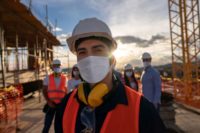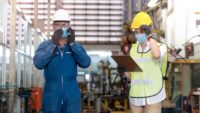COVID-19, heat safety and broader reputational risks for employer brands

It's that time of year again: As the mercury rises, so too does the risk of heat stress for employees on industrial worksites. This is nothing new for safety leaders. What is new, of course, is the external environment, which differs in ways that would have been unimaginable in previous summers.
What does that mean for organizational leaders? Two things, most of all:
- Safety risks are now linked to far broader reputational concerns due to COVID-19 that are going to positively or negatively impact employer brands over the long term.
- Handling seasonal heat stress is going to be harder due to COVID-19 requirements like personal protective equipment (PPE) and social distancing, but there are specific steps you can take to help mitigate those challenges.
Let's look at both pieces of this puzzle in greater detail, including best practices for forward-thinking leadership. Here are three insights about COVID-19, heat safety and what you can do to help mitigate the associated risks.
COVID-19 and employer branding
Whenever we finally get to the backside of the current crisis, what factors do you think will be the most important to job seekers as they vet and evaluate potential employers?
The answer, in the eyes of more than one in five employees today, is how those employers treated their employees during COVID-19, according to a recent study. Not a finding to overlook.
What's more, the scope of the crisis is such that you can't afford not to talk about it. Something like one in four company posts on LinkedIn right now, for example, make reference to COVID-19, and you need to be part of the conversation as well.
So for leaders on industrial worksites, the challenge is twofold: employee safety and communication. The good news, then, is that these two pieces go hand in hand, as we'll turn to next.
Heat safety challenges and COVID-19
The fact is, hot weather can make it uncomfortable to wear personal protective equipment (PPE) — face masks most of all — that are essential to workplace COVID-19 safety. That, in turn, puts employees at greater risk of exposure.
A few best practices to educate your team on, in that context:
- Cotton face masks tend to be the lightest weight, least irritating and most breathable facial coverings. If you can, provide these for your employees. (And make sure employees know they should be washing these daily with detergent in order for them to be safe for re-use). If limited PPE inventory or other restrains require you to ration PPE, consider posting the CDC's instructions on making effective coverings from home at locations around your worksite, as well.
- Instruct employees on the proper fit for face masks — masks should fit snugly and cover both nose and mouth, but not so tight as to restrict breathing.
- Provide your employees with extra masks or encourage them to bring extras with them to work. That way, they swap out a mask if it gets too sweaty.
- Advise all team members that moisturizing the skin can help prevent them from developing rashes.
New communication and education imperatives
From a communications standpoint, what's more, it's important to set aside time during the workday to coach all of your employees about heat stress risks as well as the new COVID-19 safety measures you've implemented.
The former should include barriers, enhanced cleaning and hygiene policies and barriers or dividers to maintain social distancing wherever possible. Keep handy this comprehensive checklist of return-to-work best practices for safety, too. As for the latter, everyone on the team should know all the signs of heat stress, common signs of overexposure in others and how to respond most appropriately in a wide range of scenarios.
For now, there remains a lot of uncertainty around COVID-19 and the workplace, but adhering to these simple best practices should help industrial organizational leaders mitigate risks that are both short-term (employer safety from heat stress) and long-term (reputational damage from employee health and safety concerns in the context of COVID-19).
Why are education and communication so key?
As I have suggested in this article, the success of your education and communication efforts in the near term could make or break the reputation of your organization going forward. During times of uncertainty, people always look to leaders for answers, guidance and reassurance, and now is the time to step up to the plate.
There may be moments, as we have discussed, when doing so requires a delicate balance of transparency and restraint (because you don't want to cause alarm), but that's the only recipe for building trust. And trust me, the net benefits — for your organization and your employees — far outweigh the risks.
Looking for a reprint of this article?
From high-res PDFs to custom plaques, order your copy today!







